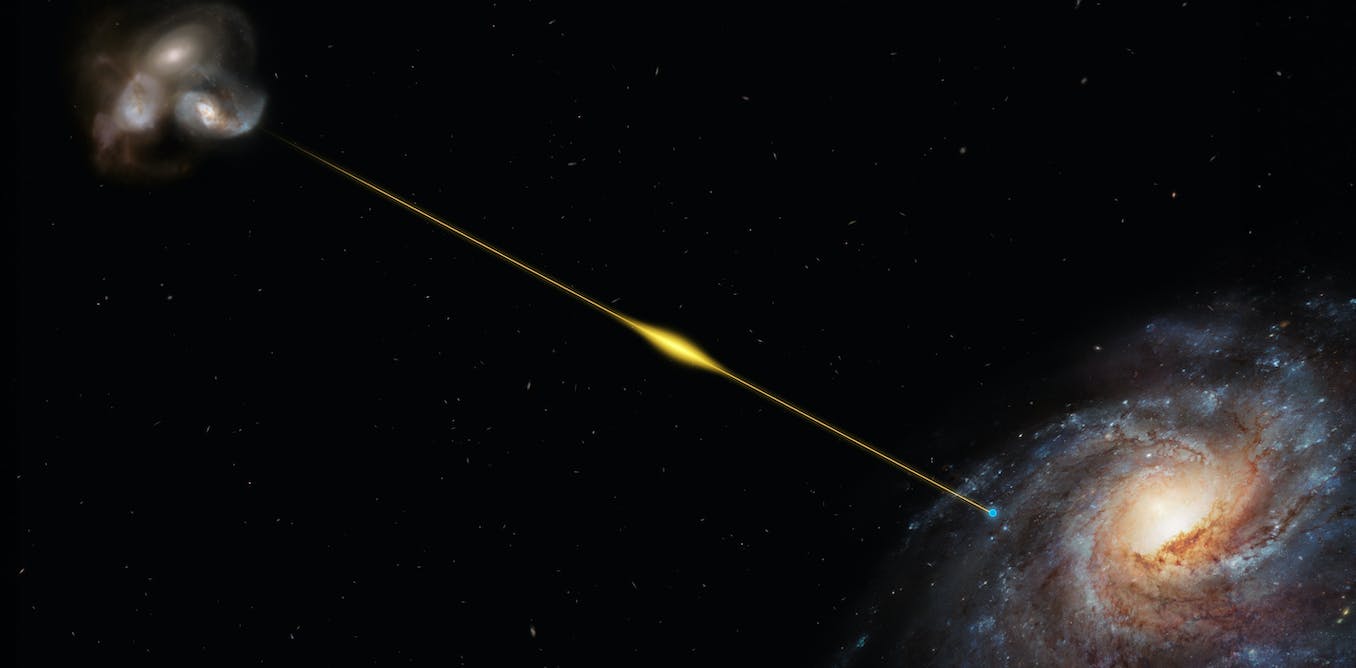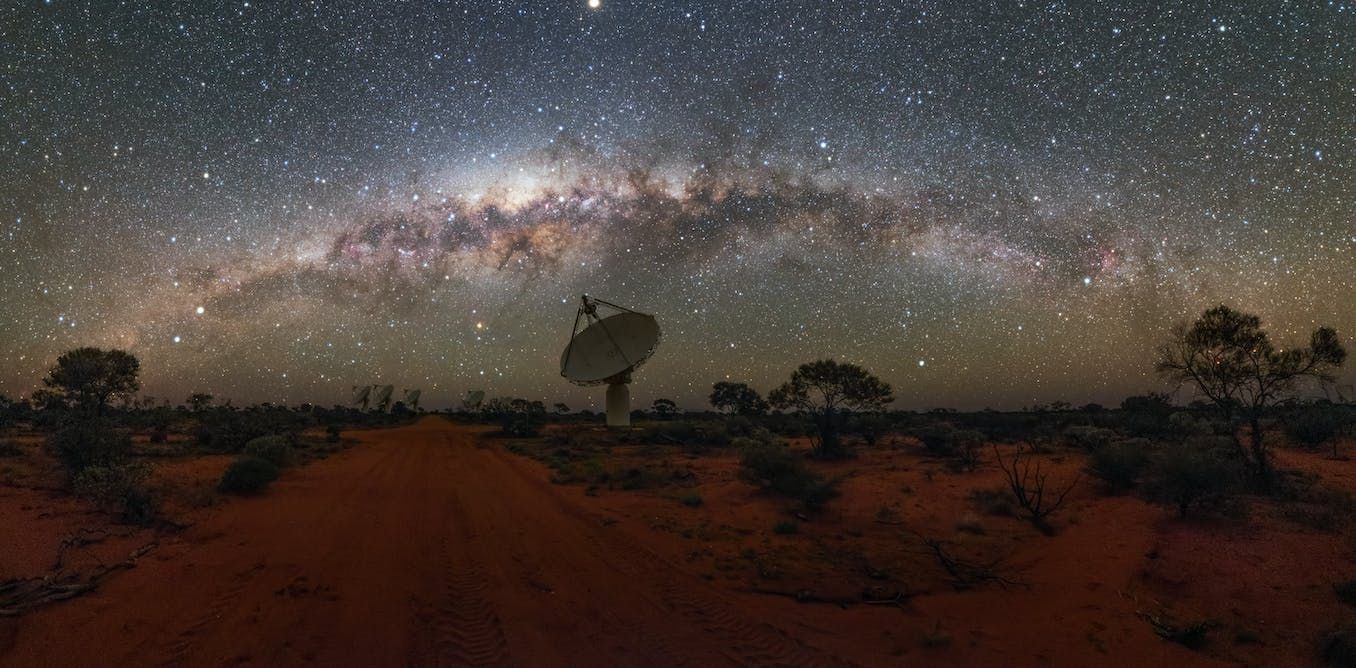We traced a powerful radio signal to the most distant source yet – a galaxy billions of lightyears away

Artist’s impression of a record-breaking Fast Radio Burst, passing from a distant host galaxy to the Milky Way. Image: ESO/M. Kornmesser
In summary
Analysis for The Conversation by Australian Research Council Future Fellow, Associate Professor Ryan Shannon
Every day and night, hundreds of thousands of intense, brief flashes of radiation suddenly flicker on and then off all across the sky. These “fast radio bursts” are invisible to the naked eye, but to a radio telescope many almost outshine everything else in the sky for a few thousandths of a second.
Since the first such burst was spotted in 2006, we have found that nearly all of them come from distant galaxies. Most bursts pass unnoticed, occurring outside the field of view of radio telescopes, and never occur again.
In new research published in Science, we have found the most distant fast radio burst ever detected: an 8-billion-year-old pulse that has been travelling for more than half the lifetime of the universe.
Seizing the opportunity
Astronomers are fascinated by fast radio bursts for two reasons.
The first is that their cause is unknown. The bursts are a trillion times more energetic than the things that look most like them: rotating neutron stars called pulsars, in our own galaxy.
The second reason is that the bursts provide a new tool to study other aspects of the cosmos.
Fast radio bursts let us study the “cosmic web” of matter floating in the space between galaxies. This matter is very hot, diffuse gas and almost invisible, but it subtly slows down fast radio bursts as they pass through it. (This is ordinary matter, the same kind that makes up stars, planets and humans, not the invisible “dark matter” that also lurks throughout the universe.)
The degree to which bursts slow down correlates with the distance they have travelled.
In 2020, analysis of fast radio bursts revealed that the cosmic web actually contains more than half of the normal matter in the universe – which astronomers had previously thought was “missing”.

The Australian Square Kilometre Array Pathfinder (ASKAP), the radio telescope used to discover and localise FRB 20220610A. Image: CSIRO
In search of the extreme
More distant and extreme fast radio bursts promise to reveal further secrets about the universe, so astronomers are on the hunt. I lead a team doing just that, using the Australian SKA Pathfinder (ASKAP) radio telescope.
On June 6 2022, our team detected and pinpointed a very bright burst with a high degree of slowing (known officially as “FRB 20220610A”). Our initial calculations suggested it might be the most distant ever found.
However, there was a possibility that the burst was closer than we thought – or that it might come from a distant galaxy too faint to be seen with an optical telescope.
We turned to one of the world’s most powerful optical observatories to search for the host galaxy: the Very Large Telescope (VLT) in Chile. The observatory’s four telescopes are equipped with cutting-edge cameras and spectrographs that can identify faint host galaxies and study their properties in detail.
At the position pinpointed by ASKAP as the source of the burst, initial images revealed faint smudges of light that looked like a distant galaxy. Analysing the spectrum of light from the galaxy showed it was strongly “redshifted”, meaning the emission from the burst has doubled in wavelength as it stretched out on its journey through the expanding universe.
The redshift had a value just over 1, which shows the burst was emitted more than 8 billion years ago, when the universe was less than half its present age. This confirmed that FRB 20220610A had broken the record for the most distant fast radio burst.

Host galaxy of FRB 20220610A, as observed by the Very Large Telescope in Red (R-band) optical light. The black circle shows the position of the FRB as measured by ASKAP. Image: Lachlan Marnoch (Macquarie Univesity/ASTRO-3D)
Pushing the limits of the universe
Like Olympic athletes, astronomers (including me) enjoy breaking records. Beyond personal satisfaction, however, this detection can also be used to explore the two fundamental questions about fast radio bursts.
First, the burst has the most energy of any that has been securely pinpointed to a location. It is more energy than our Sun puts out in 30 years, and approaches what we believe are fundamental physical limits.
The upper limit on the amount of energy any one fast radio burst can carry may be determined by quantum mechanical effects. At a certain point, the burst’s surge of radio photons may meet resistance from a sea of “virtual” electrons and positrons which British physicist Paul Dirac predicted in 1930.
Our discovery also demonstrates the potential for fast radio bursts to study the composition of the distant universe. As we look back in time, we see the structure of galaxies changes a great deal. Bursts in distant galaxies may allow us to study the detailed structure of their hosts.
Delving deeper in the cosmos
We now know that energetic bursts exist in the distant universe. As new and upgraded telescopes join the hunt for fast radio bursts, we are likely to see many more tracked down to their host galaxies.
We are currently building a new fast radio burst search system for ASKAP which will make it five times more sensitive, enabling us to push the frontier of our research further out into the universe.
And in the future, ultra-sensitive radio telescopes such as the Square Kilometre Array (SKA) will be able to detect bursts at ever greater distances. These detections will be used to map the structure of the universe and resolve the tale of a modern astronomical mystery.
This article was originally published on The Conversation.
-
Media Enquiries
Related articles

- Engineering
- Technology
- Aviation
Swinburne contributes to $270.5m Australian manufacturing research initiative
The Additive Manufacturing Cooperative Research Centre (AMCRC) seeks to transform Australia's healthcare, aerospace, and construction sectors.

- Astronomy
International team discovers the most distant spiral galaxy ever seen
Swinburne University of Technology is part of an international team that has discovered a massive, Milky Way-like spiral galaxy that formed just 1 billion years after the Big Bang, revealing an unexpectedly mature structure in the early Universe.

- Astronomy
- Technology
- Science
Swinburne’s Spotlight on STEM: A Night of Space Innovation with Shelli Brunswick
Swinburne University hosted a Spotlight on STEM event with space innovator Shelli Brunswick, exploring space technology, leadership, and career opportunities in the space industry

- Technology
- Education
- Science
- University
New Australia-India joint research institute to advance energy, communications, materials and manufacturing technologies
Swinburne University of Technology and the Indian Institute of Technology Hyderabad (IITH) have launched the Swinburne-IITH Manufacturing, Materials, Energy and Communication Technologies (SIMMECT) Joint Research Institute, to drive impactful research and global collaboration on major technology challenges.

- Health
- Science
Swinburne to boost AI-driven design for dental devices with investment in H3D
Swinburne has invested in spinout company H3D, a cutting-edge tech company that is reinventing custom-fit devices using AI and automation.
-

- Engineering
- Technology
- Aviation
Swinburne contributes to $270.5m Australian manufacturing research initiative
The Additive Manufacturing Cooperative Research Centre (AMCRC) seeks to transform Australia's healthcare, aerospace, and construction sectors.
Monday 28 April 2025 -

- Astronomy
International team discovers the most distant spiral galaxy ever seen
Swinburne University of Technology is part of an international team that has discovered a massive, Milky Way-like spiral galaxy that formed just 1 billion years after the Big Bang, revealing an unexpectedly mature structure in the early Universe.
Thursday 17 April 2025 -

- Astronomy
- Technology
- Science
Swinburne’s Spotlight on STEM: A Night of Space Innovation with Shelli Brunswick
Swinburne University hosted a Spotlight on STEM event with space innovator Shelli Brunswick, exploring space technology, leadership, and career opportunities in the space industry
Friday 21 March 2025 -

- Technology
- Education
- Science
- University
New Australia-India joint research institute to advance energy, communications, materials and manufacturing technologies
Swinburne University of Technology and the Indian Institute of Technology Hyderabad (IITH) have launched the Swinburne-IITH Manufacturing, Materials, Energy and Communication Technologies (SIMMECT) Joint Research Institute, to drive impactful research and global collaboration on major technology challenges.
Monday 03 March 2025 -

- Health
- Science
Swinburne to boost AI-driven design for dental devices with investment in H3D
Swinburne has invested in spinout company H3D, a cutting-edge tech company that is reinventing custom-fit devices using AI and automation.
Monday 31 March 2025

